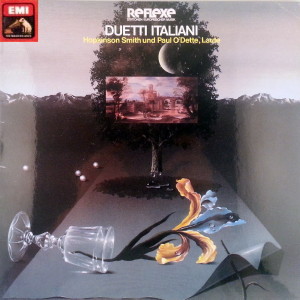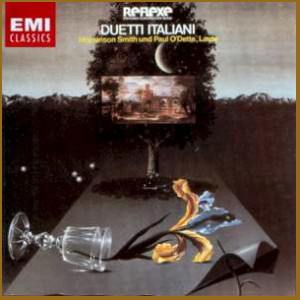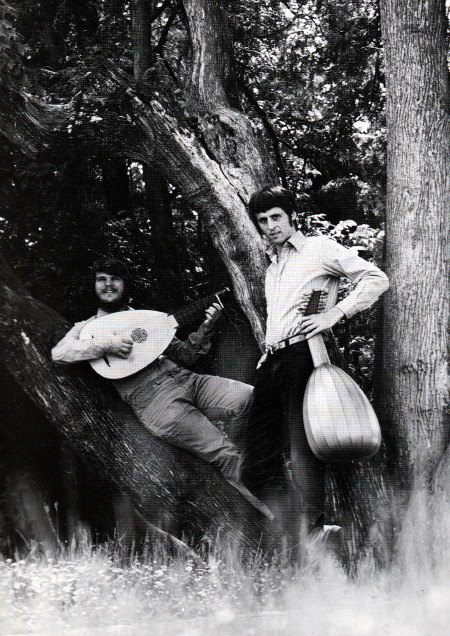 |
1 LP -
1C 065-45 642 - (p) 1979
|

|
| 1 CD - 8
26517 2 - (c) 2000 |
|
| DUETTI
ITALIANI - Italienische Lautenduette des
16. unf frühen 17. Jahrhunderts |
|
|
|
|
|
| - Chi passa
(Anonym, Herausgeber: Pierre
Phalese, 1571) - Lauten b) und
f) |
1' 39"
|
|
| - Canti di voi
le ladi (Ubert Naich,
Herausgeber: Pierre Phalese, 1571) -
Lauten b) und f) |
1' 26" |
|
| - Amor e
gratioso (Anonym, Herausgeber:
Pierre Phalese, 1571) - Lauten
b) und f) |
1' 54" |
|
- Passomezo -
Saltarello (Giovanni Pacoloni,
Herausgeber: Pierre Phalese, 1571) -
Lauten b) und f)
|
1' 58" |
|
| -
Canon (Francesco da Milano,
1497?-1573) - Lauten d) und e) |
1' 17" |
|
| -
Fantasia sexta (Francesco da
Milano, 1497?-1573 und Johannes
Matelart, Herausgeber 1559) - Lauten
d) und e) |
1' 36"
|
|
| - Fantasia terza
(Francesco da Milano, 1497?-1573 und
Johannes Matelart, Herausgeber 1559)
- Lauten c) und f) |
1' 53" |
|
| -
Spagna (Francesco da Milano,
1497?-1573) - Lauten b) und c) |
1' 33" |
|
| -
Gloria della "Missa Dixit Joseph"
(Orlando di Lasso, 1532-1594) - Lauten
a) und d) |
5' 13" |
|
| -
Calata (Joananbrosio Dalza,
Herausgeber 1508) - Lauten b)
und f) |
2' 03" |
|
| -
Saltarello Piva (Joananbrosio
Dalza, Herausgeber 1508) - Lauten
b) und f) |
4' 20" |
|
|
|
|
| - Contrapunto
primo di B.M. (Bernardo
Monzino, Herausgeber: Vincenzo
Galilei 1584) - Lauten d) und e) |
1' 58" |
|
| - Duo tutti di
fantasia (Vincenzo Galilei,
1520-1591, Herausgeber: Vincenzo
Galilei 1584) - Lauten d) und e) |
1' 11" |
|
| -
Contrapunto secondo di B.M.
(Bernardo Monzino, Herausgeber:
Vincenzo Galilei 1584) - Lauten
d) und e) |
2' 11" |
|
| -
Pavana Milanese - Saltarello
(Pietro Paolo Borrono, Herausgeber
1543) - Lauten b) und f) |
3' 15" |
|
| -
Canzona prima di Claudio da
Correggio (Giovanni Antonio
Terzi, Herausgeber 1593) - Lauten
d) und e) |
3' 38" |
|
| -
Contrapunto sopra Petit Jaquet di
Claudio da Correggio (Giovanni
Antonio Terzi, Herausgeber 1593) - Lauten
d) und e) |
4' 10" |
|
| -
Canzona seconda di Claudio da
Correggio (Giovanni Antonio
Terzi, Herausgeber 1593) - Lauten
d) und e) |
4' 08" |
|
| -
Toccata à dui Liuti
(Alessandro Piccinini, 1566-1638,
Herausgeber 1623) - Lauten d)
und e) |
3' 21" |
|
|
|
|
| Hopkinson Smith,
Laute |
Folgende Lauten
wurden verwendet: |
|
| Paul O'Dette,
Laute |
a) = 7 chörige
Sopranlaute von Mathias Durvie, Paris
1977 |
|
|
b) = 6 chörige
Altlaute von Nico van der Waals,
Oudkarspel (Niederlande) 1976 |
|
|
c) = 6 chörige
Altlaute von Stephan Murphy,
Mollans-sur-Ouvèze 1978 |
|
|
d) = 10 chörige
Tenorlaute von Nico van der Waals, Oudkarspel
(Niederlande) 1975 |
|
|
e) = 7 chörige
Tenorlaute von Joel van Lennep, Boston
(USA) 1974 |
|
|
f) = 6 chörige
Tenorlaute von Joel van Lennep, Boston
(USA) 1976 |
|
|
|
|
|
Luogo
e data di registrazione |
|
Kirche,
Séon (Svizzera) - 5-7 giugno 1978 |
|
|
Registrazione: live /
studio |
|
studio |
|
|
Producer / Engineer |
|
Gerd
Berg / Johann-Nikolaus Matthes
|
|
|
Prima Edizione LP |
|
EMI
Electrola "Reflexe" - 1C 065-45
642 - (1 lp) - durata 50' 04" -
(p) 1979 - Analogico |
|
|
Prima Edizione CD |
|
EMI
"Classics" - 8 26517 2 - (1 cd) -
durata 50' 04" - (c) 2000 - ADD |
|
|
Note |
|
- |
|
|
|
|
|
 DUETTI ITALIANI DUETTI ITALIANI
The art of duetting is
certainly as old as music
itself for what could be more
satisfying than one’s own
instrument but two ofthe same?
The resulting interaction of
two performers and their
exchange of musical ideas
creates an intensity and
vitality that is perhaps
unique in the world of chamber
music. Two equal instruments
allow the possibility of
alternating the musical
functions of melody and
accompaniment, challenging
each performer to match the
other, often in quick
succession.
Considering the popularity of
the lute in the Renaissance,
it is hardly surprising that
the lute duet became so
important and influential. The
size and diversity of this
repertoire, over five hundred
extant pieces representing
nearly every style and form of
Renaissance music, is
remarkable. The duet
literature contains many works
of great musical
sophistication and profundity,
such as Terzi’s Contrapunto
sopra Petit Jaquet and
Piccinini's
Toccata à dui Liuti,
and many with no pretense to
more than entertainment or
instruction. These latter,
including heterophonic dances
and short contrapuntal
exercises, make up in spirit
what they may lack in loftier
characteristics. Renaissance
duets thus provide the
lutenist with a literature of
extraordinary energy and
challenge. Within this
repertoire, Italian duets
stand apart in terms of
variety and virtuosity.
While most European countries
treated the lute duet as
‘Gebrauchsmusik’, in Italy it
was part of the professionals
standard repertoire. Whereas
in England, for example, duets
were frequently used as
individual display pieces, one
performer executing
spectacular variations over
the chordal accompaniment of
the other, in Italy the same
high degree of technical
proficiency was often demanded
of both players, elaborate
flourishes being tossed back
and forth. Not intoxicated by
sheer virtuosity, however, the
Italians made numerous tonal
experiments, combining lutes of
various tunings and sizes to
create special timbres and to
help distinguish polyphonic
lines more clearly. The duets
on the present recording
represent seven distinct
types:
1.
counterpoint against a chanson
or madrigal
2. melody
over a drone
3.
counterpoint over a "cantus
firmus"
4.
intabulation of a pre-existing
vocal or instrumental work
5. melodic variations
over a repeated harmonic
pattern (ground)
6. a solo
fantasia with a new,
superimposed second lute part
7. entirely
original compositions not
based on any pre-existing
material.
Early duetting was an
improvisatory art, as Johannes
Tinctoris explained in his De
Inventions et Usu
Musicae
of 1484: “Thus some teams will
take the treble of any piece
you care to give them and
improvise marvellously upon it
with such taste that the
performance cannot be
rivalled. Among such, Pietro
Bono (Avogari), lutenist to
Ercole, Duke of Ferrara, is in
my opinion pre-eminent.”
Bono, the most renowned
virtuoso of the fifteenth
century, was assisted by a
‘tenorista’, who supplied
either a drone, cantus firmus,
or the lower voices of a
chanson, over which the master
improvised fanciful disivions.
Early sixteenth century duets
in the “counterpoint against a
chanson” style maintain a
clear separation of the roles
of soloist and accompanist,
the treble lute ornamenting
the cantus line or improvising
a new discantus, while the
tenorista provided a
simplified version of the
lower two parts. Later in the
century, the accompaniment was
expanded to include all the
voices of the vocal model. The
resultant fuller texture
delegated more interest to the
accompaniment, leaving the
counterpoint less exposed, and
thus reassigning its earlier
solistic role to one of
commentary, sometimes taking
melodic initiative, sometimes
supplying a textual background
to the now selfsufficient
accompaniment. The master of
this new style was Giovanni
Antonio Terzi, whose books of
1593
and 1599
contain some of the most
sophisticated lute music ever
published. His Contrapunto
sopra Petit Jaquet
covers an incredible three and
one-half octave range,
including breath-taking leaps
and jazzy syncopations. The
Saltatello and Piva of Dalza
represent the last remnants of
the medieval tradition of
improvisation over a drone.
The repetitive nature of a
drone allowed the improviser
to utilize his extensive "bag
of tricks", including hemiolas
and dissonances. The main
responsibilities of the
tenorista were rhythmic drive
and solidity, although he
certainly added a few
cross-rhythms and ornaments of
his own.
La Spagna was the most
popular cantus during the late
fifteenth and early sixteenth
centuries. In
Francesco da Milano’s
setting it is concealed in the
middle of a chordal
accompaniment over which he
composed a graceful, flowing
countermelody. Although not
one of Francesco's more
involved works, it makes a
pleasant contrast to the
complex polyphony for which he
is primarily known.
The skill of a lutenist was
often judged by his ability to
devise imaginative
arrangements of chansons,
madrigals, motets and
canzonas. In
making these intabulations, a
lutenist rarely maintained the
precise notes of the original,
but usually employed a certain
amount of ornamentation
rendering them more idiomatic
for his instrument. The lute
cannot sustain the long notes
commonly Found in vocal music,
as the sound of a plucked
string dies rapidly. These
long notes were replaced with
scale passages through which
the lutenist could crescendo
or decrescendo as a singer
would do on a sustained note.
Three contrasting approaches
to intabulation
are represented on this
recording. The Gloria from Lassus'
Missa
Super Dixit Joseph
is mostly
unembellished, runs having
been added only as was deemed
necessary to facilitate
phrasing. Canti di voi le
ladi and Amor e
gratioso are somewhat
more elaborately embellished,
but the basic structure of the
originals remain. Claudio da
Correggio’s two Canzone on the
other hand, are barely
recognizable through Terzi’s
flamboyant ornamentation. The
new works which result,
however, attest to the
artistry oflan imaginative
intabulater.
Such artistic license was as
controversial then as it is
today. Writers such as Ganassi
and Zacconi contended that
performers who didn't ornament
were not thought well of by
their colleagues, while Josquin
and Zarlino, among others,
argued that ornamentation was
unnecessary and served only to
disrupt the counterpoint.
Contrasting the complexities
of vocal music are the simple
repeated harmonies of the
ground bass dances. The two
most common Renaissance
grounds were the Passamezo
antico and the Passamezo
moderno: Borrono’s Pavana
Milanese and Saltarello
are based on the former, Pcoloni's
Passamezo and Saltarello on
the latter. The chord
progressions of Chi passa
are
derived from
a street song ofthe same name.
Although the Contrapunto
secondo begins like a
Passamezo moderno,
there are no repeated paterns,
and, in fact,
both of the so-called
“grounds” to B.M.'s Contrapunti
are through-composed in a
madrigalesque manner, These
pieces are essentially
ricercars, one lute
functioning in a predominately
harmonic fashion, the other
providing rhythmic and melodic
impetus.
In
1559, the Flemish lutenist Johannes
Matelart
published several of Francesco
da Milano's solo
fantasias, to which he had
composed a second lute part.
These new parts, while partly
obscuring the original
compositions, enrich the
texture with additional points
of imitation, parallel thirds,
and parallel sixths, creating
a lushness of sound immatched
at this early date.
The latest surviving
Renaissance duet, and perhaps
the most spectacular, is the Toccata
à dui Liuti by
Alessandro Piccinini. Not
content with the strict
separation of melody and
accompaniment roles, Piccinini
at times supplies passagework
in both parts simultaneously.
Moving either in parallel or
in contrary motion, this
device builds energy and aids
in gathering momentum.
Although the contrapuntal
style is that of the
Renaissance, the contrasting
sectionalism ushers in the
world of the Baroque. The
grand dimensions of this piece
bring to a close the era of
the Renaissance lute duet and
serve as an appropriate finale
to this recording.
Paul
O'Dette
|
|
|
EMI Electrola
"Reflexe"
|
|
|
|

